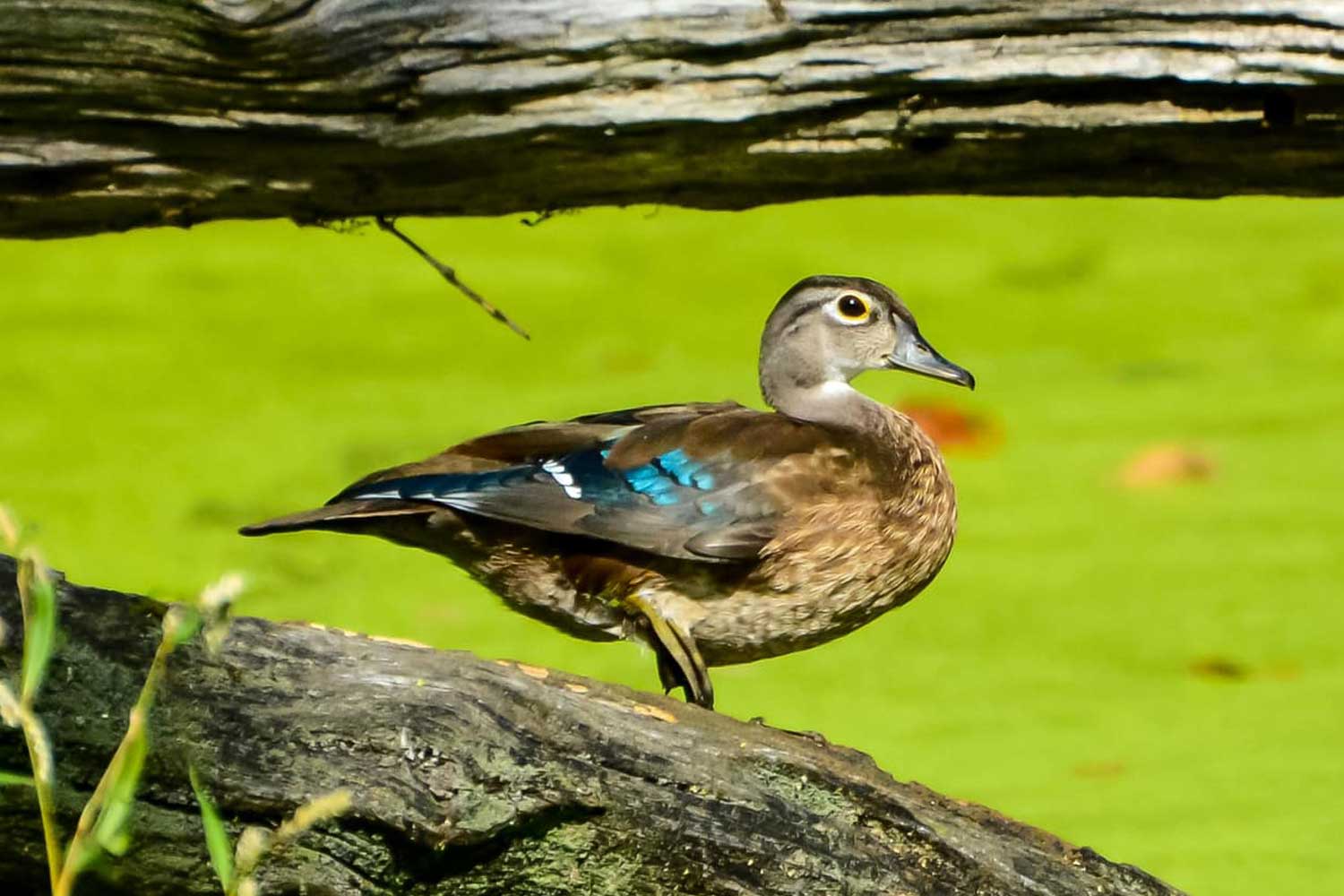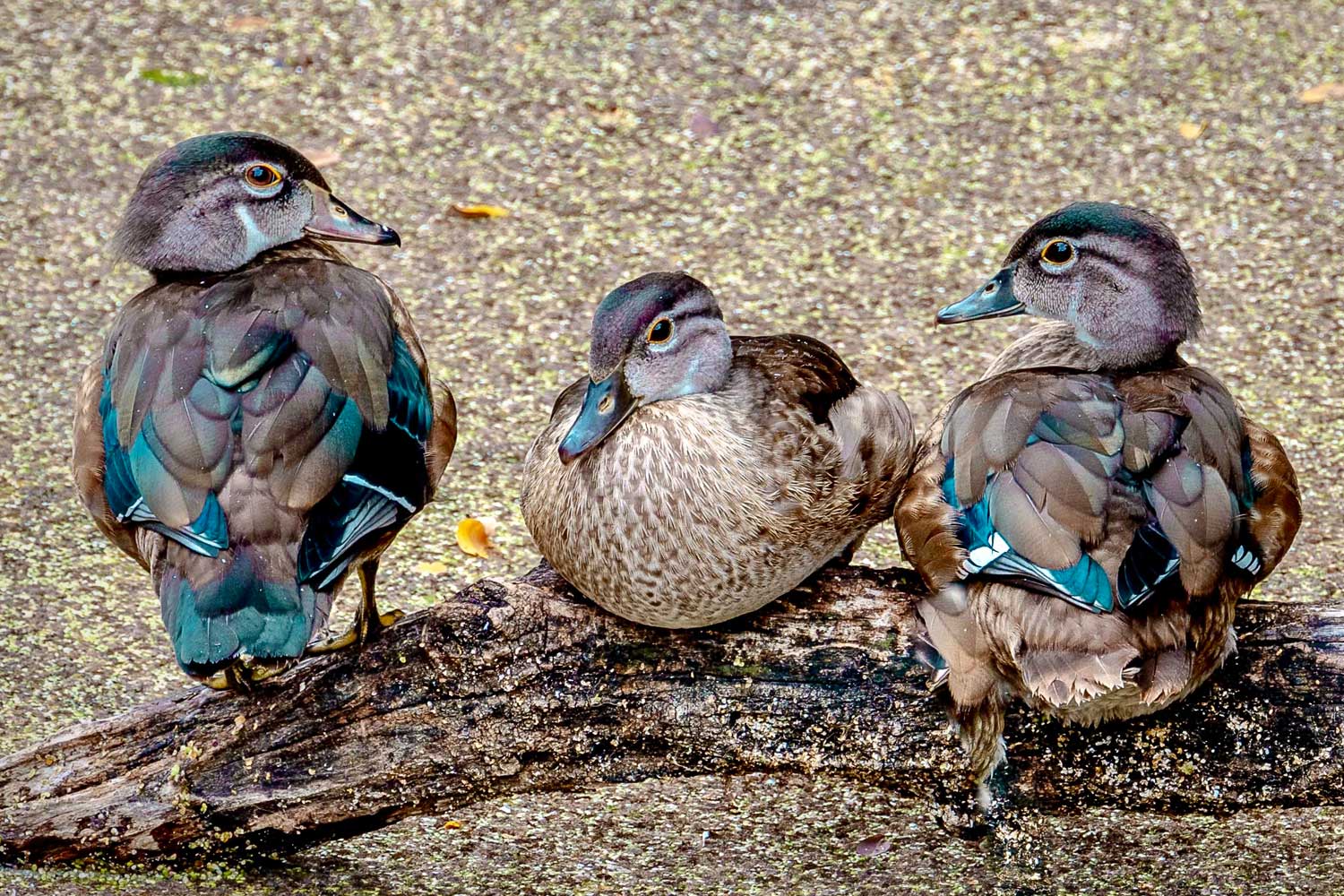Five fast facts about ornate wood ducks

Our waters are home to many duck species, but none as ornate as the wood duck, which looks like a duck dressed up for a special occasion. As is common among ducks, it's the males that are most striking, sporting bold white stripes along with a chestnut breast and flashes of emerald green. Females are more subdued, but with blue patches on their wings and a noticeable white ring around their eyes.
Wood ducks don't favor open expanses of water like some of our other common waterfowl species. They prefer marshy or swampy areas or other slow-moving bodies of water where they can take cover in the vegetation, according to the Cornell Lab of Ornithology. While on the water, they forage for insects, seeds and other foods, but they will also go on land to eat acorns and other nuts.
Read on to learn what makes wood ducks unique among our local ducks.
They love trees
We usually associate ducks with water, and wood ducks do spend time in and near the water, but these ducks are more associated with trees and forests than our other duck species. They even nest in trees, usually in cavities created naturally or in holes used by other birds because they cannot make their own nesting cavities, according to the Cornell Lab of Ornithology.
They prefer to nest in trees along the shore or over water, and they look for large trees that are 1 foot to 2 feet in diameter. They will nest at almost any height in a tree, but spots higher up in a tree seem to be their preference, the Cornell Lab reports.
Because they spend so much time in trees, wood ducks have claws on their webbed feet that help them perch and climb on tree branches, the American Bird Conservancy reports. Their wing structure also allows them to fly in tight spaces, which helps them navigate through the trees of the forest they inhabit.
Their ducklings must take a leap of faith
Because wood ducks nest in trees, their ducklings have a big jump to make soon after hatching. Only a day after hatching, these baby ducks must leap from their nests to the ground below. It's an impressive feat considering their nests can be more than 65 feet above the ground, according to the National Wildlife Federation.
The ducklings aren't injured on the long fall, however. They are so lightweight that they safely flutter down. Once landed, their mother will call for them to join her in the nearby water. Wood ducks often nest in trees over water so this long drop can be straight into the water below, the American Bird Conservancy reports.
The mother will care for her ducklings for five or six weeks after hatching, according to the National Audubon Society. After about two months, the young ducks can fly.
They can have a lot of ducklings
The wood duck is the only duck in North America that commonly produces two broods of offspring in a breeding season, the Cornell Lab reports. This contributes to the large number of offspring wood ducks can produce, but it's not the only factor. The females will typically lay between six and 16 eggs per brood. This is not too much greater than a mallard, which will lay between one and 13 eggs per brood.
However, consider that wood ducks often have two broods in a breeding season, doubling their offspring in a given year. This is typical in the southern part of their territory, while wood ducks in the northern reaches of their range may only have one brood, the Audubon Society reports.
Even more ducklings can be hatched each season because of a practice called egg dumping. When wood ducks establish nests close to other wood duck nests, the females sometimes lay eggs in nests other than their own, the National Wildlife Federation reports. For this reason, wood duck nests have been found with as many as 40 eggs. When females lay their eggs in another wood duck's nest, the other duck will incubate the eggs and raise the ducklings as her own.
They don't quack
We usually learn that ducks quack at about the same point in our childhood that we learn that cows moo and pigs oink, but in reality most ducks don't quack. Only mallards do, and only females mallards at that. That's not to say wood ducks are quiet. They have distinct calls and sounds, but they don't quack. And males and females make distinctly different sounds, as is the case with many duck species.
Males call out in flight, and it sounds like a high-pitched whistle, according to the American Bird Conservancy. They repeat the call many times. Females, on the other hand, have a louder call that sounds like a squeak: oo-eek, oo-eek. Beyond these most identifiable sounds, wood ducks have other vocalizations as well that they use for courtship and during nesting.
Their appearance can change throughout the year
Wood ducks — males especially — are among our most striking birds, but the males don't always sport their ornate plumage. Their feathers are flashy for one reason only: to attract a mate. Once breeding season is over, in late summer, the males lose their colorful plumage and it is replaced with something more subdued, the National Wildlife Federation reports.
By late summer, male wood ducks have lost their bold striping and pale colored feathers on their sides. Instead, they are mostly gray or grayish-brown with white facial markings and some blue feathers on their wings, according to the wildlife federation. This look is called their eclipse plumage, and it will last until breeding season begins again. Although they look less striking at this time, they are still identifiable by their brightly colored bill and red eyes.
Female wood ducks do not change their appearance throughout the year, the Cornell Lab reports. Both male and female juvenile wood ducks look similar in appearance to the adult females.







